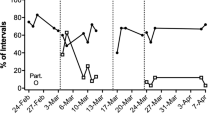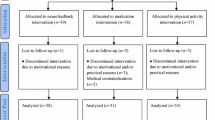Abstract
Using fidget toys is one way to allow students with attention-deficit/hyperactivity disorder (ADHD) to move while completing academic assignments in the classroom. This study investigated the effect of fidget spinners on the on-task behavior of three second-grade students with ADHD. Before beginning treatment, the rules of use were briefly explained and demonstrated to students by the researchers; students were then provided with fidget spinners during treatment sessions in language arts class. A multiple-baseline design across students was used to determine whether each student had higher levels of on-task behavior when using the fidget spinner. Momentary time sampling was used to record on-task behavior; visual analysis of time-series graphs showed large immediate and sustained increases in on-task behavior during fidget spinner use. Implications for implementing a fidget spinner intervention and suggestions for future research are discussed.

Similar content being viewed by others
References
Alderson, R. M., Rapport, M. D., Kasper, L. J., Sarver, D. E., & Kofler, M. J. (2012). Hyperactivity in boys with attention deficit/hyperactivity disorder (ADHD): The association between deficient behavioral inhibition, attentional processes, and objectively measured activity. Child Neuropsychology, 18(5), 487–505. https://doi.org/10.1080/09297049.2011.631905.
American Psychiatric Association, DSM-5 Task Force. (2013). Diagnostic and statistical manual of mental disorders (5th ed.). American Psychiatric Publishing, Inc.. https://doi.org/10.1176/appi.books.9780890425596
Arnold, L. E., Hodgkins, P., Kahle, J., Madhoo, M., & Kewley, G. (2020). Long-term outcomes of ADHD: Academic achievement and performance. Journal of Attention Disorders, 24(1), 73–85. https://doi.org/10.1177/1087054714566076.
Barton, E. E., Reichow, B., Schnitz, A., Smith, I. C., & Sherlock, D. (2015). A systematic review of sensory-based treatments for children with disabilities. Research in Developmental Disabilities, 37, 64–80. https://doi.org/10.1016/j.ridd.2014.11.006.
Carmouche, M., Thompson, J., & Carter, L. (2018). Effects of professional development and videoconferencing on the increase of opportunities to respond and the on-task behavior of students with emotional behavior disorders. Journal of Information Technology Education: Research, 17, 127–157. https://doi.org/10.28945/4060.
Carson, S., Shih, M., & Langer, E. (2001). Sit still and pay attention? Journal of Adult Development, 8, 183–188. https://doi.org/10.1023/A:1009594324594.
Cheng, M., & Boggett-Carsjens, J. (2005). Consider sensory processing disorders in the explosive child: Case report and review. The Canadian Child and Adolescent Psychiatry Review, 14(2), 44-48
Cook, B. G., Tankersley, M., & Harjusola-Webb, S. (2008). Evidence-based special education and professional wisdom: Putting it all together. Intervention in School and Clinic, 44(2), 105–111. https://doi.org/10.1177/1053451208321566.
Davis, T. N., Dacus, S., Bankhead, J., Haupert, M., Fuentes, L., Zoch, T., Kang, S., Attai, S., & Lang, R. (2014). A comparison of self-monitoring with and without reinforcement to improve on-task classroom behavior. Journal of School Counseling, 12(12), 1–23.
Fabiano, G. A., & Pyle, K. (2019). Best practices in school mental health for attention-deficit/hyperactivity disorder: A framework for intervention. School Mental Health, 11(1), 72–91. https://doi.org/10.1007/s12310-018-9267-2.
Favell, J. E., McGimsey, J. F., & Schell, R. M. (1982). Treatment of self-injury by providing alternate sensory activities. Analysis and Intervention in Developmental Disabilities, 2(1), 83–104. https://doi.org/10.1016/0270-4684(82)90007-6.
Foster, R. (2014). Barriers and enablers to evidence-based practices. Kairaranga, 15(1), 50–58.
Gaastra, G. F., Groen, Y., Tucha, L., & Tucha, O. (2016). The effects of classroom interventions on off-task and disruptive classroom behavior in children with symptoms of attention-deficit/hyperactivity disorder: A meta-analytic review. PLOS ONE, 11(2), Article e0148841. https://doi.org/10.1371/journal.pone.0148841.
Graziano, P. A., Garcia, A. M., & Landis, T. D. (2020). To fidget or not to fidget, that is the question: A systematic classroom evaluation of fidget spinners among young children with ADHD. Journal of Attention Disorders, 24(1), 163–171. https://doi.org/10.1177/1087054718770009.
Grodner, K. (2015). To fidget or not to fidget: The effect of movement on cognition (Publication No. 1599141) [Master’s thesis, Nova Southeastern University]. ProQuest. https://search.proquest.com/docview/1728335820
Hartanto, T. A., Krafft, C. E., Iosif, A. M., & Schweitzer, J. B. (2016). A trial-by-trial analysis reveals more intense physical activity is associated with better cognitive control performance in attention-deficit/hyperactivity disorder. Child Neuropsychology, 22(5), 618–626. https://doi.org/10.1080/09297049.2015.1044511.
Hornby, G., Gable, R. A., & Evans, W. (2013). Implementing evidence-based practice in education: What international literature reviews tell us and what they don’t. Preventing School Failure: Alternative Education for Children and Youth, 57(3), 119–123. https://doi.org/10.1080/1045988X.2013.794326.
Hulac, D. M., Aspiranti, K. B., Kriescher, S., Briesch, A., & Athanasiou, M. (2020). A multisite study of the effect of fidget spinners on academic performance. Contemporary School Psychology. https://doi.org/10.1007/s40688-020-00292-y.
Kercood, S., Grskovic, J. A., Lee, D. L., & Emmert, S. (2007). The effects of fine motor movement and tactile stimulation on the math problem solving of students with attention problems. Journal of Behavioral Education, 16, 303–310. https://doi.org/10.1007/s10864-007-9042-1.
Klein, R. G., Mannuzza, S., Olazagasti, M. A., Roizen, E., Hutchison, J. A., Lashua, E. C., & Castellanos, F. X. (2012). Clinical and functional outcome of childhood attention-deficit/hyperactivity disorder 33 years later. Archives of General Psychiatry, 69(12), 1295–1303. https://doi.org/10.1001/archgenpsychiatry.2012.271.
Ledford, J. R., Zimmerman, K. N., Severini, K. E., Gast, H. A., Osborne, K., & Harbin, E. R. (2020). Brief report: Evaluation of the noncontingent provision of fidget toys during group activities. Focus on Autism and Other Developmental Disabilities, 35(2), 101–107. https://doi.org/10.1177/1088357620902501.
Martens, B. K., Witt, J. C., Elliott, S. N., & Darveaux, D. X. (1985). Teacher judgments concerning the acceptability of school-based interventions. Professional Psychology: Research and Practice, 16, 191–198. https://doi.org/10.1037/0735-7028.16.2.191.
Mastropieri, M. A., & Scruggs, T. E. (2018). The inclusive classroom: Strategies for effective differentiated instruction (6th ed.). Pearson Education.
Murphy, E. S., McSweeney, F. K., Smith, R. G., & McComas, J. J. (2003). Dynamic changes in reinforcer effectiveness: Theoretical, methodological, and practical implications for applied research. Journal of Applied Behavior Analysis, 36(4), 421–438. https://doi.org/10.1901/jaba.2003.36-421.
Ng, Q. X., Ho, C. Y. X., Chan, H. W., Yong, B. Z. J., & Yeo, W. S. (2017). Managing childhood and adolescent attention-deficit/hyperactivity disorder (ADHD) with exercise: A systematic review. Complementary Therapies in Medicine, 34, 123–128. https://doi.org/10.1016/j.ctim.2017.08.018.
Pappas, S. (2017). Fidget spinners: What they are, how they work and why the controversy. www.livescience.com/58916-fidget-spinner-faq.html
Parker, R. I., & Vannest, K. (2009). An improved effect size for single-case research: Nonoverlap of all pairs. Behavior Therapy, 40(4), 357–367. https://doi.org/10.1016/j.beth.2008.10.006.
Parker, R. I., & Vannest, K. J. (2014). Non-overlap analysis for single-case research. In T. R. Kratochwill & J. R. Levin (Eds.), Single-case intervention research: Methodological and statistical advances (pp. 127–151). American Psychological Association. https://doi.org/10.1037/14376-005.
Patros, C. H., Tarle, S. J., Alderson, R. M., Lea, S. E., & Arrington, E. F. (2019). Planning deficits in children with attention-deficit/hyperactivity disorder (ADHD): A meta-analytic review of tower task performance. Neuropsychology, 33(3), 425–444. https://doi.org/10.1037/neu0000531.
Pelham III, W. E., Page, T. F., Altszuler, A. R., Gnagy, E. M., Molina, B. S., & Pelham Jr., W. E. (2020). The long-term financial outcome of children diagnosed with ADHD. Journal of Consulting and Clinical Psychology, 88(2), 160–171. https://doi.org/10.1037/ccp0000461.
Radloff, R. (2019). Insight observation timer (1.3.2) [mobile app]. App Store. https://apps.apple.com/us/app/insight-observation-timer/id1212950867
Rapport, M. D., Bolden, J., Kofler, M. J., Sarver, D. E., Raiker, J. S., & Alderson, R. M. (2009). Hyperactivity in boys with attention-deficit/hyperactivity disorder (ADHD): A ubiquitous core symptom or manifestation of working memory deficits? Journal of Abnormal Child Psychology, 37, 521–534. https://doi.org/10.1007/s10802-008-9287-8.
Sagvolden, T., Johansen, E. B., Aase, H., & Russell, V. A. (2005). A dynamic developmental theory of attention-deficit/hyperactivity disorder (ADHD) predominantly hyperactive/impulsive and combined subtypes. Behavioral and Brain Sciences, 28(3), 397–418. https://doi.org/10.1017/S0140525X05000075.
Sanetti, L. M. H., & Kratochwill, T. R. (2009). Toward developing a science of treatment integrity: Introduction to the special series. School Psychology Review, 38(4), 445–459. https://doi.org/10.1037/14275-001.
Schecter, R. A., Shah, J., Fruitman, K., & Milanaik, R. L. (2017). Fidget spinners: Purported benefits, adverse effects, and accepted alternatives. Current Opinion in Pediatrics, 29(5), 616–618. https://doi.org/10.1097/MOP.0000000000000523.
Shapiro, E. S. (2011). Academic skills problems fourth edition workbook. The Guildford Press.
Slater, D., & French, J. (2010, March 9-12). Fidget toys in the classroom: Refocusing attention [presentation]. SoTL Commons Conference, Statesboro, GA. https://digitalcommons.georgiasouthern.edu/sotlcommons/SoTL/2010/4
Slattery, L., Crosland, K., & Iovannone, R. (2016). An evaluation of a self-management intervention to increase on-task behavior with individuals diagnosed with attention-deficit/hyperactivity disorder. Journal of Positive Behavior Interventions, 18(3), 168–179. https://doi.org/10.1177/1098300715588282.
Soares, J. S., & Storm, B. C. (2020). Putting a negative spin on it: Using a fidget spinner can impair memory for a video lecture. Applied Cognitive Psychology, 34(1), 277–284. https://doi.org/10.1002/acp.3610.
Somma, A., Carlotta, D., Boni, F., Arlotta, E., Masci, E., Busso, S., Cerioli, C., Manini, R., Borroni, S., & Fossati, A. (2019). Reliability and validity of the structured clinical interview for DSM-5–Clinician Version (SCID-5-CV) attention deficit/hyperactivity disorder criteria: Preliminary evidence from a sample of 217 Italian adolescents. Journal of Psychopathology, 25, 3–9.
Soria-Claros, M., Serrano-Marugan, I., Quintero, J., & Ortiz, T. (2016). The effect of passive tactile stimulation in the brain activity of children with attention deficit. Revista De Neurologia, 62, 103–107.
Stalvey, S., & Brasell, H. (2006). Using stress balls to focus the attention of sixth-grade learners. Journal of At-Risk Issues, 12(2), 7–16.
Author information
Authors and Affiliations
Corresponding author
Ethics declarations
Conflict of interest
Kathleen B. Aspiranti declares she has no conflict of interest; David M. Hulac declares he has no conflict of interest.
Ethical approval
All procedures performed in studies involving human participants were in accordance with the ethical standards of the institutional and/or national research committee and with the 1964 Helsinki declaration and its later amendments or comparable ethical standards.
Informed consent
Informed consent was obtained for all participants included in the study.
Additional information
Publisher’s Note
Springer Nature remains neutral with regard to jurisdictional claims in published maps and institutional affiliations.
Appendix
Appendix

Rights and permissions
About this article
Cite this article
Aspiranti, K.B., Hulac, D.M. Using Fidget Spinners to Improve On-Task Classroom Behavior for Students With ADHD. Behav Analysis Practice 15, 454–465 (2022). https://doi.org/10.1007/s40617-021-00588-2
Accepted:
Published:
Issue Date:
DOI: https://doi.org/10.1007/s40617-021-00588-2




